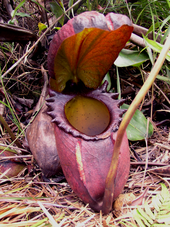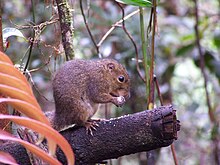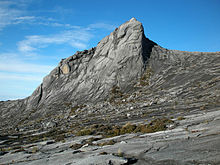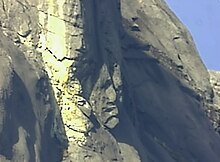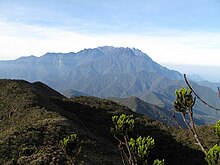Porter Kinabalu, Guide Kinabalu, Paket Wisata Gunung Kinabalu
Mount Kinabalu, Pendakian Gunung Kinabalu
From Wikipedia, the free encyclopedia
Mount Kinabalu, Pendakian Gunung Kinabalu
From Wikipedia, the free encyclopedia
| Mount Kinabalu | |
|---|---|
| Gunung Kinabalu | |

Mount Kinabalu
|
|
| Highest point | |
| Elevation | 4,095 m (13,435 ft) |
| Prominence | 4,095 m (13,435 ft) Ranked 20th |
| Isolation | 2,538 kilometres (1,577 mi) |
| Listing | Country high point Ultra Spesial (Ribu) |
| Coordinates | 6°5′N 116°33′ECoordinates: 6°5′N 116°33′E |
| Geography | |
| Location | Sabah, Malaysia |
| Parent range | Crocker Range |
| Climbing | |
| First ascent |
March 1851 Hugh Low (summit plateau) 1888 John Whitehead (highest peak) |
| Easiest route | Hiking |
In 1997, a re-survey using satellite technology established its summit (known as Low's Peak) height at 4,095 metres (13,435 ft) above sea level, which is some 6 metres (20 ft) less than the previously thought and hitherto published figure of 4,101 metres (13,455 ft).[2]
Mount Kinabalu includes the Kinabalu montane alpine meadows ecoregion in the montane grasslands and shrublands biome. The mountain and its surroundings are among the most important biological sites in the world, with between 5,000 and 6,000 species of plants, 326 species of birds, and more than 100 mammalian species identified. Among this rich collection of wildlife are famous species such as the gigantic Rafflesia plants and orangutans. Mount Kinabalu has been accorded UNESCO World Heritage status.[3][4][5]
Low's Peak can be climbed by a person in good physical condition and there is no need for mountaineering equipment at any point on the main route.[6]
Contents
Biology
Mount Kinabalu along with other upland areas of the Crocker Range is known worldwide for its botanical and biological species biodiversity with plants of Himalayan, Australasian, and Indomalayan
origin. A recent botanical survey of the mountain estimated a
staggering 5,000 to 6,000 plant species (excluding mosses and liverworts
but including ferns),[2][7][8][9][10][11]
which is more than all of Europe and North America (excluding tropical
regions of Mexico) combined. It is therefore one of the world's most
important biological sites.
In 2015, a major Malaysian-Dutch study showed that the unique flora,
fauna, and fungi on the mountain summit are younger than the mountain
itself, and have evolved from both local and distant montane ancestors.[12]
Flora
The flora covers the mountain in zones of different types of habitat as one climbs up, beginning with a lowland belt of fig trees and insectivorous pitcher plants. Then between 2,600 to 3,200 m (8,530 to 10,499 ft) is a layer of short trees such the conifer Dacrydium gibbsiae and dwarf shrubs, mosses, lichens, liverworts, and ferns. Finally many of the world's richest variety of orchids are found on the high rockier slopes.
Large lower pitcher of Nepenthes rajah.
These plants have high levels of endemism
(i.e. species which are found only within Kinabalu Park and are not
found anywhere else in the world). The orchids are the best-known
example with over 800 species including some of the highly valued Paphiopedilum slipper orchids, but there are also over 600 species of ferns
(more than the whole of Africa's 500 species) of which 50 are found
nowhere else, and the richest collection in the world for the Nepenthes
pitcher plants (five of the thirteen are found nowhere else on earth)
which reach spectacular proportions (the largest-pitchered in the world
being the endemic Nepenthes rajah).[2][13][14] The parasitic Rafflesia plant, which has the largest single flower in the world, is also found in Kinabalu (particularly Rafflesia keithii whose flower grows to 94 centimetres (37 in) in diameter),[2] though it should be noted that blooms of the flower are rare and difficult to find. Meanwhile, another Rafflesia species, Rafflesia tengku-adlinii, can be found on the neighbouring Mount Trus Madi and the nearby Maliau Basin.
Its incredible biodiversity
in plant life is due to a combination of several unique factors: its
setting in one of the richest plant regions of the world (the tropical
biogeographical region known as western Malesia which comprises the island of Sumatra, the Malay Peninsula, and the island of Borneo),
the fact that the mountain covers a wide climatic range from near sea
level to freezing ground conditions near the summit, the jagged terrain
and diversity of rocks and soils, the high levels of rainfall (averaging
about 2,700 millimetres (110 in) a year at park HQ), and the climatic
instability caused by periods of glaciation and catastrophic droughts which result in evolution and speciation. This diversity is greatest in the lowland regions (consisting of lowland dipterocarp forests, so called because the tree family Dipterocarpaceae are dominant). However, most of Kinabalu's endemic species are found in the mountain forests, particularly on ultramafic
soils (i.e. soils which are low in phosphates and high in iron and
metals poisonous to many plants; this high toxic content gave rise to
the development of distinctive plant species found nowhere else).[2]
Fauna
A mountain squirrel, Sundasciurus tenuis, from Mount Kinabalu.
The variety of plant life is also habitat for a great variety of
birds and mammals. There are some 326 species of birds in Kinabalu Park,
including the spectacular rhinoceros hornbill, mountain serpent-eagle, Dulit frogmouth, eyebrowed jungle flycatcher, and bare-headed laughingthrush.
Twenty-four birds are mainly found on the mountain. The mountain is
home to some 100 mammalian species mostly living high in the trees,
including one of the four great apes, the orangutan (though sightings of these are uncommon; estimates of its numbers in the park range from 25 to 120).[2] Other mammals include three kinds of deer, the Malayan weasel (Mustela nudipes), oriental small-clawed otter (Aonyx cinerea), and leopard cat (Felis bengalensis). Endemic mammals include the black shrew (Suncus ater) and Bornean ferret-badger (Melogale everetti).
Endemic annelids number less than a dozen known species but include the Kinabalu giant red leech that preys on various earthworms, including the Kinabalu giant earthworm.[15] In the summit zone, at least 26 endemic species of land snail exist.[16] In 2012, a major scientific expedition, jointly organised by the Malaysian Sabah Parks and the Dutch Naturalis Biodiversity Center, performed DNA analysis of several dozen endemic flora, fauna, and fungi, to understand the evolutionary origin of the unique biodiversity of Kinabalu.[17]
Threats and preservation
The steep mountainsides with poor soil are not suitable for farming
or for the timber industry so the habitats and animal life of Kinabalu
remain largely intact, with about a third of the original habitat now
degraded. Kinabalu Park was established in 1964 and the nearby mountains
were protected as the Crocker Range National Park
in 1984. However even national park status does not guarantee full
protection, as logging permits were granted on Trus Madi in 1984.[18]
Geology
Summit of Mount Kinabalu.
Mount Kinabalu is essentially a massive pluton formed from granodiorite which is intrusive into sedimentary and ultrabasic rocks,
and forms the central part, or core, of the Kinabalu massif. The
granodiorite is intrusive into strongly folded strata, probably of Eocene to Miocene age, and associated ultrabasic and basic igneous rocks.
It was pushed up from the earth's crust as molten rock millions of
years ago. In geological terms, it is a very young mountain as the
granodiorite cooled and hardened only about 10 million years ago. The
present landform is considered to be a mid-Pliocene
peneplain, arched and deeply dissected, through which the Kinabalu
granodiorite body has risen in isostatic adjustment. It is still pushing
up at the rate of 5 mm per annum. During the Pleistocene Epoch of about 100,000 years ago, the massive mountain was covered by huge sheets of ice and glaciers
which flowed down its slopes, scouring its surface in the process and
creating the 1,800-metre (5,900 ft) deep Low's Gully (named after Hugh Low)
on its north side. Its granite composition and the glacial formative
processes are readily apparent when viewing its craggy rocky peaks.[2]
History
British colonial administrator Hugh Low
made the first recorded ascent of Mount Kinabalu's summit plateau in
March 1851. Low did not scale the mountain's highest peak, however,
considering it "inaccessible to any but winged animals".[19] In April and July 1858, Low was accompanied on two further ascents by Spenser St. John, the British Consul in Brunei.[2] The highest point of Mount Kinabalu was finally reached in 1888 by zoologist John Whitehead.[2] British botanist Lilian Gibbs became the first woman and the first botanist to summit Mount Kinabalu in February 1910.[2]
Botanist E. J. H. Corner led two important expeditions of the Royal Society of Great Britain to the mountain in 1961 and 1964.[2] Kinabalu National Park was established in 1964. The park was designated a natural World Heritage Site in 2000.[20]
2015 earthquake
On 5 June 2015 at 07:15 MST,
the area around Mount Kinabalu was damaged by an earthquake. Eighteen
people, including hikers and mountain guides, were killed by the
earthquake and a massive landslide that followed it. Ranau and many
parts of Sabah West Coast were affected and Donkey Ear's Peak was heavily damaged.[21]
Six days before the earthquake, around ten western tourists
(comprising six men and four women from Canada, Germany, Netherlands and
the United Kingdom)[22] "stripped and urinated at the mountain (which locals believe has angered the spirit at the sacred place)".[23][24] The tourists also allegedly shouted vulgarities when they were told to desist by their mountain guide,[25][26] but this was later dismissed by the judge in their trial.[citation needed]
This provoked outrage among certain Sabahans, who want all of the
alleged offenders charged in native court and forced to pay the "sogit",
a type of compensation, given in the form of money or livestock, to
appease the aggrieved party according to local Kadazan-Dusun customs. It is imposed on wrongdoers for the purpose of appeasing "the aggrieved", thus placating the community.[27]
However, as most of the detained tourists have been released from
Malaysia's prison and escaping native court, the local villagers had to
perform their own rituals.[28]
Following the incident, some of the tourists and their families have
expressed their apologies to all involved parties, and the government of
the United Kingdom began to review its travel advice for Malaysia.[29][30]
Climbing permit
Sabah Parks
grants a summit-climbing permit only to climbers who stay at mountain
huts. Due to the limited number of beds at the mountain huts, only 130
persons are allowed to climb Mount Kinabalu per day. There are only 3
types of mountain hut owned by either Sutera Sanctuary Lodges, Mountain
Torq or Sabah Parks. Accommodation package can be purchased directly from them.[citation needed] (The hut owned by Sabah Parks is restricted only to Malaysians.)
Climbing route
Climbers must be accompanied by accredited guides at all times due to
national park regulations. There are two main starting points for the
climb: the Timpohon Gate (located 5.5 km from Kinabalu Park
Headquarters, at an altitude of 1,866 metres (6,122 ft)),[31] and the Mesilau Nature Resort.
The latter starting point is slightly higher in elevation, but crosses a
ridge, adding about two kilometres to the ascent and making the total
elevation gain slightly higher. The two trails meet about two kilometres
before Laban Rata.
Accommodation is available inside the park or outside near the
headquarters. Sabah Parks has privatised Mount Kinabalu activities to an
organisation called Sutera Sanctuary Lodges. The mountain may be
climbed on a single day trip, or hikers may (usually) stay one night at
Laban Rata Resthouse at 3,270 metres (10,730 ft) to complete the climb
in 2 days, finishing the ascent and descending on the second day. The
majority of climbers begin the ascent on day one of a two-day hike from
Timpohon gate at 1,866 metres (6,122 ft), reaching this location either
by minibus or by walking, and then walk to Laban Rata. Most people
accomplish this part of the climb in 3 to 6 hours. Since there are no
roads, the supplies for the Laban Rata Resthouse are carried by porters,
who sometimes bring more than 35 kilograms of supplies on their backs.
Hot food and beverages are available at Laban Rata. Most rooms have no
hot water in the bathrooms and whilst the dining area is heated, most
rooms are not. The last 2 kilometres (6,600 ft), from the Laban Rata
Resthouse at 3,270 metres (10,730 ft) to Low's Peak (summit) at 4,095.2
metres (13,436 ft), takes between 2 and 4 hours. The last part of the
climb is on bare granite rock.
Given the high altitude, some people may suffer from altitude sickness[32]
although staying overnight at the lodges before the climb and climbing
at a lower rate of ascent may reduce the likelihood of this happening.
Low's gully
Low's Gully (named after Hugh Low who first looked down into it in 1851) is a 1,800-metre (5,900 ft) deep gorge carved out by glaciation
on the north side of Mount Kinabalu, that is one of the least explored
and most inhospitable places on earth. In March 1994 two British Army
officers were severely criticised after leading a party of 7 British and
3 Hong Kong soldiers in an attempt to abseil
and climb down into the gully that required extensive rescue efforts
from both the RAF and the Malaysian army. The party were not equipped
with radios and the 2 officers and 3 Hong Kong soldiers were trapped for
16 days and did not eat for five days before being rescued when
stretchers were lowered by helicopter. The breakaway party of five
completed the first descent of the gully in three days.[33] A book about the 31-day fight for survival entitled Descent Into Chaos was published in 1996 and a film drama The Place of the Dead
was released in 1997. The first successful complete descent of Low's
Gully was achieved by a 27 strong joint Malaysian-British team led by
mountaineer and former British Army officer Pat Gunson in 1998.[34][35]
Naming myths
"Kina Balu from Pinokok Valley" – lithograph published in 1862.
A visual illusion of a rock face on Mt. Kinabalu. Caught on camera from a location in Mesilau, December 2011.
Mount Kinabalu viewed from the summit of nearby Mount Tambuyukon.
There are two stories that led to the main beliefs in the origin of
the mountain's name. The first derivation of the word Kinabalu is
extracted from the short form for the Kadazan-Dusun
word 'Aki Nabalu', meaning "the revered place of the dead". Meanwhile,
it can also be believed that the name "Kinabalu" comes from the Dusun
phrase "tina balu" which means "a widow mother". So, assumably, tina balu is the spirit of the mount itself. Considering the fact that the word "Kinabalu" in many Dusun dialects literally means 'mountain', means that this explanation is the most likely.
A popular story told to Western and Chinese tourists states that the
name "Kinabalu" actually means "Cina Balu" (which would fully mean "A
Chinese Widow").[36] Due to the lingual influence among the Kadazan Dusun of Sabah, the pronunciation for the word "cina" (chee-na) was changed to "Kina" (kee-na).[37] Nobody actually knows when or where this story came from but it seems to have originated within the last 30 years.
It was told that a Chinese prince, was cast away to Borneo when his ship sank in the middle of the South China Sea.
He was subsequently rescued by the natives from a nearby village. As he
recovered, he was slowly accepted as one of the people of the village.
Eventually, he fell in love with a local woman, and married her. Years
went by, and he started to feel homesick. So he asked permission from
his newly found family to go back to China to visit his parents (the Emperor
and Empress of China). To his wife, he promised that as soon as he was
done with his family duties in China, he would come back to Borneo to
take her and their children back to China. When he made his return to
China, he was given a grand welcome by his family. However, to his
dismay, his parents disagreed with him about taking his Bornean wife
back to China. Worse, they told him that he was already betrothed to a
princess of a neighbouring kingdom. Having no choice (due to high respect towards his parents), he obeyed with a heavy heart.
Meanwhile, back in Borneo, his wife grew more and more anxious.
Eventually, she decided that she would wait for her husband's ship.
However, since the village was situated far away from the coast, she
couldn't afford to come to the shore and wait for him daily. Instead she
decided to climb to the top of the highest mountain near her village,
so that she could have a better view of the ships sailing in the South
China Sea. Thus, she was then seen climbing up the mountain at every
sunrise, returning only at night to attend to her growing children.
Eventually her efforts took their toll. She fell ill, and died at the
top of the cold mountain while waiting for her husband. The spirit of the mountain,
having observed her for years, was extremely touched by her loyalty
towards her husband. Out of admiration for this woman, the spirit of the
mountain turned her into a stone.[36]
Her face was made to face the South China Sea, so that she could wait
forever for her dear husband's return. The people in her hometown who
heard about this were also gravely touched by this. Thus, they decided
to name the mountain "Kinabalu" in remembrance of her. To them, the
mountain is a symbol of the everlasting love and loyalty that should be
taken as a good example by women.
Local legend among the people of Ranau, a district in Sabah, has it that St. John's Peak was the stone which her body was turned into.
Temperature
The
temperature of Mount Kinabalu usually stands from −4 °C to 8 °C in
December to January, and 3 °C to 12 °C in June to September. Due to the
coldness of the mountain in December to January, sometimes frost, ice or even snow appears at the summit of Mount Kinabalu.[38][39]
See also
- Borneo lowland rain forest – ecoregion
- Borneo montane rain forests – ecoregion
- Backpacking
- Mount Kinabalu International Climbathon
Notes
- Given the definition of the Malay Archipelago excluding New Guinea, where about 22 mountains exceed 4100 m.
References
- Tang Ruxyn (10 February 2017). "Ice Sheets And 'Snow' Have Formed On Mount Kinabalu!". Says.com. Retrieved 19 June 2017.
Further reading
- Thomas Fuller (9 April 1999). Into the Mists of Borneo's Kinabalu. The New York Times.
- Hugh; Midori Paxton (7 March 2001). Climb rain forests to the clouds. The Japan Times.
- Jim Solicki (23 June 2001). They came, they climbed: Mount Kinabalu conquered. The Globe and Mail.
- Jocasta Webb (1 September 2001). The truth about Mount Kinabalu. The Guardian
- Flip Byrnes (18 August 2010). Least-known, most exhilarating hikes. Stuff.co.nz
- Niall McIlroy (9 July 2011). Man versus mountain. The West Australian.
- Gabby Salazar (2 June 2014). Sunrise Hiking on Mount Kinabalu. National Geographic
- Sasha Gonzales (14 April 2015). 'If hell were a mountain, it would look like Mount Kinabalu': a Hong Kong hiker's Borneo blues. South China Morning Post
- Amy Willis (11 June 2015). What are the rules on climbing Mount Kinabalu and why is it so sacred?. Metro.
Call Center ExploreWisata.com,
085.643.455.685
D72E559E / 7A722B86
Instagram : instagram.com/xplore.wisata
Instagram : instagram.com/xplore.gunung
Instagram : instagram.com/syarifain
Fanspage Umum : facebook.com/xplore.wisata
Fanspage Gunung : facebook.com/xplore.gunung
Website :
Instagram : instagram.com/xplore.gunung
Instagram : instagram.com/syarifain
Fanspage Umum : facebook.com/xplore.wisata
Fanspage Gunung : facebook.com/xplore.gunung
Website :
#porter #guide #pemandu #transport lokal #rinjani 3.726 mdpl #semeru 3.676 mdpl #slamet 3.428 mdpl #lawu 3.265 mdpl #merbabu 3.145 mdpl #sindoro 3.150 mdpl #gunungprau 2.565 mdpl #gunungsikunir #porterrinjani #portersemeru #porterargopuro #portermerbabu #porterlawu #porterslamet #portersumbing #portersindoro #kaosadventure #kaosbacpacker #backpackerindonesia #opentripsemeru #opentripmerbabu #opentripkarimunjawa #opentriprinjani #cikuray #gede #parango #gunungsalak #bromo #karimunjawa #guapindul #raftingsungaielo #raftingelo #raftingprogo #tangkubanperahu
#derawan #belitung #pahawang #cartensz piramid, #trekkingcartensz #cartenz murah #sevensummit
Tags:
Gunung Kinabalu



